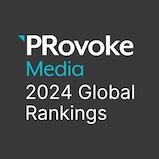Arun Sudhaman 01 Sep 2017 // 1:30PM GMT

As the midpoint of 2017 recedes into the distance, it already seems optimistic to expect the PR industry to outpace the 7.4% revenue growth it recorded last year.
That result, as per our Global PR Agency Rankings, followed a dispiriting 2015 — when topline growth at the world's 250 biggest PR firms slowed to 5%. Fast forward to today and it appears that publicly-held PR firms from the 'Big 4 holding groups' — which together account for around 30% of the global PR market — may well struggle to match that performance, if results from the first half of this year are any guide.
Indeed, even for an industry that has grown inured to the sight of marginal gains at some of its major players, the second-quarter revenue decline has come as a discomforting surprise. Omnicom's PR firm revenue decreased by 0.3%. WPP PR growth slowed to 0.6%. And, after consistently outperforming the market for years, Interpublic surprised many by reporting that PR revenues dropped in Q2.
This, remember, is after PR agencies from the Big 4 holding groups grew by just 3.8% in 2016 to $4.7bn, comfortably outstripped by independent agencies that increased fee income by 9% to around $5bn. And there is little to suggest that this trend is likely to change any time soon.
WPP CEO Sir Martin Sorrell has blamed a slowdown in client advertising spending for the company's decision to cut its sales growth forecast to between 0 and 1% for this year. Sorrell pointed in particular to consumer goods giants such as Unilever and P&G, which are slashing costs and trimming marketing budgets to notable effect — with major implications for agency fees.
Yet, should advertising cutbacks affect PR agencies? It is a question that gains added currency at a time when engagement, authenticity, transparency, credibility — the things that PR is good at — are increasingly critical to successful brand-building. The response favoured from PR professionals, of course, would be 'no'. But things are rarely that simple.
As consumer goods giants come under pressure from mediocre growth and activist investors, advertising becomes one of the easier budget items to trim. And holding groups, bolstered by their insatiable relationships with these companies, are most vulnerable. But those cutbacks do not just affect advertising and media agencies — they also spell danger for the multi-agency structures that WPP and its peers have put in place to serve broader marketing communications assignments for these clients, many of which involve considerable levels of PR agency support.
By wrapping their services together with their advertising and media siblings (whether at the behest of procurement or not) publicly-held PR firms are finding their fortunes inextricably tied to larger advertising trends. This is not to pretend that public relations is recession-proof, or even counter-cyclical, but as a more nimble, less costly and — in theory — more effective engagement approach, PR agencies should be afforded a measure of protection from advertising budget cuts.
Many independent PR firms would go one step further, and suggest that their service portfolio does not just mitigate against current conditions, but actually represents an entrepreneurial opportunity. They would no doubt point to their stellar growth record as evidence of how an ability to invest ahead of the curve has helped propel business growth amid difficult economic conditions.
Most of the big publicly-held PR agencies would be hard-pressed to make a similar claim. Network heads I have spoken to in recent weeks bemoan the bottomline focus, which itself echoes the zero-based budgeting that is increasingly beloved of their clients. Rather than being viewed as a vehicle for growth, their firms are uniformly subjected to the same cost-cutting regime as their advertising brethren — evidenced by layoffs and restructuring at several players.
Even independent firms, though, could be forgiven a measure of introspection in light of recent events. Consider P&G brand officer Marc Pritchard's recent comments on the state of digital marketing, often viewed as the promised land for growth-oriented PR agencies.
"In our quest to do dynamic, real-time marketing in the digital age, we were producing thousands of ads, posts and tweets because we thought the best way to cut through the clutter was to create more ads," said Pritchard, whose company found that sales growth was unaffected by its decision to slash $100m in digital marketing costs.
Pritchard talks in terms of advertising, but his comments are equally applicable to PR firms in today's integrated landscape, who are just as likely to be steering paid digital campaigns. And Pritchard, furthermore, is exactly the kind of CMO that smarter PR firms have been targeting as they attempt to prove their relevance to the marketing executives who increasingly—as our Global Communications Report research shows—control the purse strings.
All of which means that even the best-performing PR firms will be wary of a marketing slowdown, amid the broader economic uncertainty and political turbulence that forms the backdrop to 2017. Yet, while these do not add up to the best of times for the PR industry, it seems clear that independent players are better-placed to weather the worst. And, if nothing else, it suggests that — as my colleague Paul Holmes put it earlier this year — "the much-ballyhooed ‘consolidation’ of our industry is a chimera."
Instead, clients — whether comms directors or marketers — are increasingly looking for best-in-breed agencies in individual markets and for individual audience segments. As PR comes to be seen as more and more mission critical, this trend is only likely to continue and expand.



































.jpg)

















